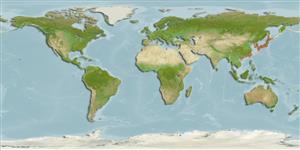Common names from other countries
Environment: milieu / climate zone / depth range / distribution range
Ecologie
; brakwater; diepteverspreiding 0 - 6 m (Ref. 385). Subtropical
Northwest Pacific: from south of Japan to the south of Sakhalin.
Length at first maturity / Size / Gewicht / Leeftijd
Maturity: Lm ?, range 2 - ? cm Max length : 4.0 cm SHL mannelijk/geslacht niet bekend; (Ref. 127304); Maximaal vermelde leeftijd: 10 jaren (Ref. 127304)
Found in subtidal areas of estuaries in mud (Ref. 75831). Infaunal suspension-feeder (Ref. ).
Life cycle: Embryos develop into free-swimming trocophore larvae, succeeded by the bivalve veliger, resembling a miniature clam (Ref. 833).
SAUP Database. 2006. (Ref. 356)
Status op de Rode Lijst van het IUCN (Ref. 130435)
Status bij CITES (Ref. 108899)
Not Evaluated
Not Evaluated
Gebruik door de mens
Visserij: commercieel
FAO - Visserij: landings, soortsprofiel | FishSource | Sea Around Us
Tools
Internet-bronnen
Estimates based on models
Preferred temperature
(Ref.
115969): 5.6 - 22.6, mean 14 (based on 372 cells).
Weerstandsvermogen
Hoog, minimale populatieverdubbelingstijd minder dan 15 maanden (K=0.2-1.11; tm=3; tmax=10).
Prijsklasse
Unknown.
